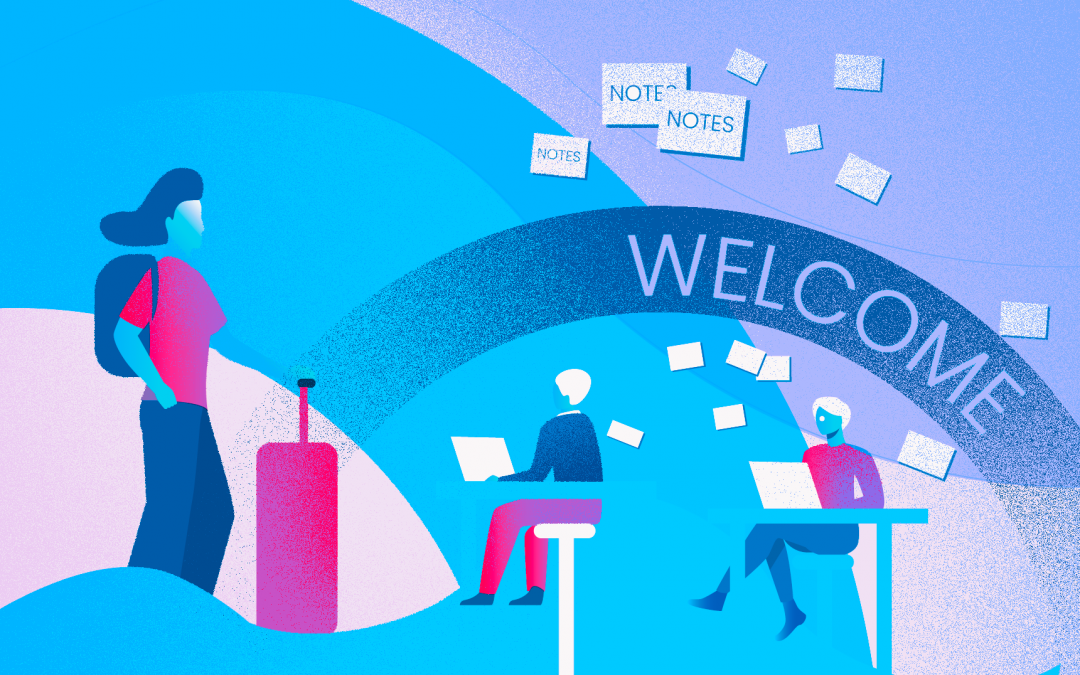It’s happened to you too.
You start a new job and you’ve been stuck for days (weeks? months?)
Not having a clue about things and feeling a bit pushy every time you have to ask another question (because no one has explained anything to you).

What you think everyone is saying about you
What amounts to a full-blown «the new guy» syndrome.
And it’s not cool.
This situation makes you feel uncomfortable, and if it goes on forever, several things can happen (none of them good).
The good news is that none of these things need to happen if you design a proper onboarding process.
Let us explain what onboarding is and why it is in your best interest to avoid many (bad) things for your employees, for your company and, if things get out of hand, even for world peace.
Read on, we’ll tell you all about it.
What is onboarding?
Onboarding is «that thing» that happens between the arrival of «the new guy» and the moment when (s)he is integrated into your staff and giving his/her all for your company.
It makes your new recruits feel welcome and well integrated into the team.
And you don’t do that by giving the new hire a handbook to «entertain» them during their first day on the job.
That will only make them feel forgotten and they will perceive a disorganization that no one wants for the company they are starting to work for.

When «the new guy» doesn’t get over it
Bad for your new hire, for whom a never-ending «the new guy» syndrome is predicted. Bad for your company, which will have lost a unique opportunity to create a good first impression on a member of its staff. With this onboarding, this is what you will achieve in the short term:
- Demotivation.
- Lack of productivity.
- Risk of talent loss.
- The costs derived from all this.
Yes, we know that you don’t have enough time to get all your daily work done and that a new incorporation will disrupt your agenda.

But think that the design of a good onboarding plan will save you a lot of time in future incorporations.
Advantages of a good onboarding process
What do you get by making the new member of your staff feel welcome and quickly grasp the culture and operation of your company?
- You shorten (or eliminate) the «new guy» syndrome.
Members integrated into the team ipso facto. - Talent retention is increased.
No one wants to work in a company that is disorganized or where they feel they are not valued; without proper onboarding your new hires will leave as soon as they can. - Improve productivity.
The new member of your staff will have the necessary tools to be more autonomous and do their job better. - Commitment to the company is increased.
Onboarding and motivation go hand in hand. The first days are key to make the new members of your team feel comfortable and identified with the values of your company. - Cost reduction.
A motivated and efficient workforce is the best thing that can happen to your organization; and that is exactly what you get with a good onboarding. - Improves the perception of the company by the staff.
It is essential for your team to commit to your values and objectives.
Phases of an onboarding process
The more extensive the onboarding process is, the more effective it will be. So, extend it without fear and use it to integrate the new member into the training process of your company. However, we can divide it into several phases:
1. Pre-onboarding
Why wait until the day of incorporation? Pre-onboarding allows you to start preparing the ground for the new member of your team before you even meet them.
It starts with the job offer
The job offer should help you find your new recruit, but also give them enough information to decide whether they are interested in working with you or not. Give them as much information as possible about the position and about your company. It is also the perfect place to start sharing your company culture.
Take advantage of the days leading up to the start of the job
Don’t wait until you have them in the office or sitting at their computer at home on their first day of work to give them a lot of documentation to read. This will only saturate them (and waste their time).

This one didn’t make it to the second day
Send them information about the company and documentation they need to read before they start. Do you have a welcome manual? Now is the time to share it.
Explain what their first day on the job is going to be like
There’s nothing better than a good first-day jitters to keep them from holding back important information. Take the uncertainty out of your new team member’s mind by telling them what they will find when they arrive at your company. It will help them calm down and introduce themselves with more confidence.
2. The first days of onboarding
This is when the «new guy» syndrome can start to take its toll on your new hire. How can you avoid it?
Explain what they need to know to get by in your company
Many organizations see the onboarding process as orienting the new hire so that (s)he can more or less manage as they desperately try to get a foothold.
Optimistic companies, no doubt.
The same ones that then see how staff turnover wastes a lot of time and money, as well as a lot of talent.
Make sure the new member of your team knows your company, accompany them and show them where everything is and how you work, but don’t leave them to their own devices at this point (unless you don’t mind losing them or they can’t do their job well).
Introduce them to your team
And, if it can be the entire staff, all the better.

If you’re a small company, making a mental map of who’s who and how everyone can help them will give you a lot of autonomy when doing their job.
Appoint a host for their first days
A reference person who can answer any questions they may have during those days and to whom they can turn to in confidence. This is essential for them to adapt more easily to their new job.
Doses of information
Predictably, your new recruit will be a human being (and will have the cognitive limits of his/her species). Do not saturate their brain with all the information they will need throughout their career with you; it is counterproductive, believe us.
3. Nonstop onboarding
If many companies end their onboarding by showing new hires where the kitchen and bathrooms are, you can imagine that nonstop onboarding is science fiction for them. What can you do to avoid making the same mistake?
Do a weekly onboarding follow-up
Sit down once a week (Fridays are ideal for an informal coffee) to give them feedback and solve all the doubts that will surely have arisen during those days. They will appreciate it and you will use it as a measuring apparatus to know how they are adapting and if they need something more from you to join your company in the best possible way.
Explain your company’s internal processes
If you have established procedures, there is a reason. Make sure they know them; you will avoid confusion, waste of time and bewilderment on the part of your new recruit.
What is your product like and who is it aimed at?
If your team does not know what the final objective of their work is, we are in trouble. What does your company do? What for? Give them the opportunity to get to know your product or service in depth and to know who it is aimed at and how it solves their needs.

(Wild) product immersion
It will help them to have a complete vision of your company and to situate themselves within it.
Team building
Teambuilding, that thing that sounds so American, is, in fact, basic for your company. Give your teams the possibility to get to know each other beyond their daily work interaction and create personal bonds between them. In short: create community and a sense of belonging to your company. Very important to create good vibes.
Continually train your teams
In life we never stop learning (and we’d better); in your company, the same applies. Train your teams continuously to improve their skills and keep them motivated. Training is one of the points most valued by the staff when it comes to staying in a company; take it into account to retain internal talent in your organization.
Design a digital onboarding to succeed
Now that you know what you have to give your new hire to make their onboarding a memorable process, you just have to choose one last thing: how.
How are you going to give them that information?
You have 2 options:
The first: bombard them with data (spoiler alert: it goes wrong).
Instructions for a 2-step failure:
- Bury them under a pile of documents (physical or virtual) to store all that information in their poor human brain (good luck).
- Put a person on top of them to solve every single doubt that comes up (which will not be few).
If you want to waste a lot of time and resources and overwhelm the new employee until they want to escape from your company, congratulations: this is your option.
Absolute guarantee of boredom and, therefore, lack of learning (boring training is what they have: they don’t work #that’sthat).
The second one: to do an epic digital onboarding.
The best option in any case, but even more so if you work remotely.
You must agree with me on this.
Working remotely has good things, but avoiding isolation and lack of information from your teams is an extra effort compared to face-to-face work.
Getting to know the staff becomes more complicated, the contact with colleagues stops, and you can forget about asking questions to the first person who passes by your side.
That’s why it is important to take (great) care of the welcoming phase of the new incorporation into the team and, in addition, to give constant feedback.

Failed onboarding
All right, but what about training? What about those questions your desk colleagues can’t solve? We love it when you ask us these questions (because you’ll love the answers).
1. Train your teams (well) with gamified trainings
Why are we such fans of gamification? and microtraining?
Well, because of 3 little things:
- They are practical.
Your teams can learn at any time and from anywhere.
When it suits them best.
You only need a device with an Internet connection and off you go. - They are fun (= effective).
Micro-trainings last between 5 and 10 minutes (just enough to not saturate the brain and make information easy to retain).
In addition, gamification makes learning fun and facilitates the assimilation of concepts. - They are measurable.
You can check the progress of your staff members and create content to meet the learning needs you detect in your company.
2. Solve all your staff’s doubts with a chatbot
Okay, working remotely we can’t use the colleague next to us to solve doubts, but what if you had the knowledge of all the members of your team always at hand and just one click away?
That’s what you get with a doubt-solving chatbot. What are the advantages?
- Your teams save (a lot of) time searching for information.
- Experts in your organization save all the time they spend answering the same questions again and again.
- Your staff learns constantly.
Do you need help with your company’s onboarding process?
Do you? Well, you’ve come at the right time to try for free the tool with which you’ll be able to create that epic digital onboarding we were talking about before.
Do you want to put an end to the dreaded syndrome of «the new guy» in your company? And save time by solving in a jiffy all the doubts that slow down your work?
Good news, well, with Zapiens you can do all that (and a little more that we have not told you yet).
Sign up at Zapiens and give our app a try to create a memorable digital onboarding for your company.
You can register up to 20 users for free, and forever!
As you hear; are you up for it?
FREE for up to 20 users
The easiest way to train your team, manage knowledge in your company and learn something new every day.

